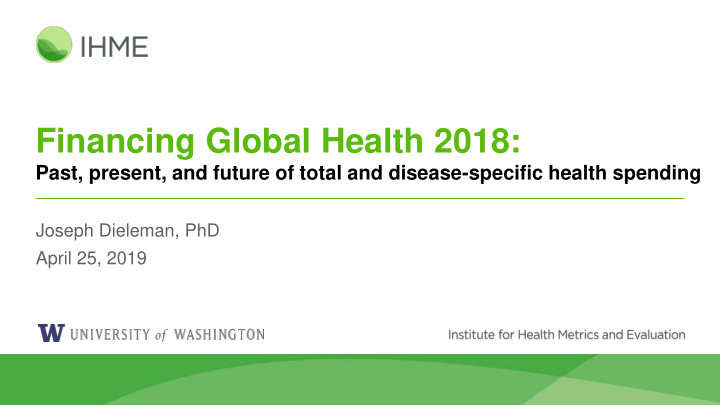



Financing Global Health 2018: Past, present, and future of total and disease-specific health spending Joseph Dieleman, PhD April 25, 2019
A huge thank you to: 1. Kaiser Family Foundation and Center for Strategic and International Studies Thank you 2. Bill and Melinda Gates Foundation 3. IHME team: Angela Chang, Krycia Cowling, Abby Chapin, Catherine Chen, Annie Haakenstad, Connor Harle, Gloria Ikilezi, Margot Kahn Case, Mark Moses, Nafis Sadat, Miranda Tao, Goli Tsakalos, Yingxi Zhao, Bianca Zlavog, Kat Beame, Kelly Bienhoff, Adrienne Chew, Selina Deiparine, Kris Krohn, Katie Leach-Kemon, Michaela Loeffler, Angela Micah, Kate Muller, Chris Murray, Molly Nixon, Dean Owen, Disha Patel, Anna Torre, Joan Williams, Junjie Wu, and Teddy Younker 4. Global Burden of Disease Health Financing Collaborator Network www.healthdata.org/gbd/call-for-collaborators
10 years of Financing Global Health reports 2009–2017 became a global authority on 2018 focuses on domestic health development assistance for health spending, DAH, HIV/AIDS, and malaria
Financing Global Health papers 1 2 Joseph L Dieleman, Angela E Micah, and Christopher JL Murray
Financing Global Health papers 3 4
Interactive visualization : https://vizhub.healthdata.org/fgh/
Outline I. Past, present, and future of total health spending II. Development assistance for health III. Disease specific health spending – HIV/AIDS and malaria IV. Health spending and universal health coverage
Total health spending, 2016 - $8.0 trillion THE pc map Health spending per person 8
Total health spending, 2016 - $8.0 trillion Global population Global health spending 0.4% 17% 16% 3% 35% 10% 81% 39%
How is health spending changing? Health spending per person 1995 Gross domestic product per person
How is health spending changing? Health spending 2016 per person 1995 Gross domestic product per person
How is health spending changing? 2030 Health spending 2016 per person 1995 Gross domestic product per person
How is health spending changing? 2050 2030 Health spending 2016 per person 1995 Gross domestic product per person
How is health spending changing? Health spending per person in high-income countries Health spending per person Health spending per person in low-income countries 14
Development assistance for health - $38.9 billion DAH bar chart Billions of 2018 US dollars 15
Development assistance for health - $38.9 billion 0.6% annual growth 11.8% annual DAH bar chart growth Billions of 2018 US 4.9% annual growth dollars 16
Development assistance for health - $38.9 billion DAH bar chart Billions China - of 2018 $645m US dollars US - $13.2b 17
Development assistance for health - $38.9 billion 2018 2011-2018 growth rate Billions of 2018 US dollars SWAP / $5.6b -0.7% HSS DAH stacked bar by HFA Maternal $4.7b 1.9% Child $7.8b 6.2% Malaria $2.1b -0.4% TB $1.6b 2.2% HIV $9.5b -3.0%
HIV/AIDS and malaria spending HIV/AIDS spending (low- and middle-income countries) Malaria spending (106 endemic countries) Global project Global project and admin and admin Development assistance Development assistance Out-of-pocket Government Government spending spending
HIV/AIDS spending - $19.9b in low- and middle-income 1. Treatment and prevention by financing source Donor Billions of funding 2018 US dollars Domestic funding 20
HIV/AIDS spending - $19.9b in low- and middle-income 2. Percent of HIV/AIDS spending from DAH, 2016 21
HIV/AIDS spending – 3. Measuring the potential for additional government, 2016 22
Malaria spending – 1. Malaria spending by elimination status, 2016 Billions of 2018 US dollars 23
Malaria spending – 2. Malaria spending by source and incidence, 2016 Development assistance for malaria Modeled fraction of total malaria spending OOP Government spending (Elimination countries) (Controlling countries)
What does this mean for universal health coverage? Health spending per person in high-income countries Health spending per person Health spending per person in low-income countries
What does this mean for universal health coverage? 100% 75% Percent of health spending that is domestic, prepaid 50% 25% 3.2 billion people live in countries with OOP and DAH making up > 50% of health spending
Thank you dieleman@uw.edu
Recommend
More recommend